-
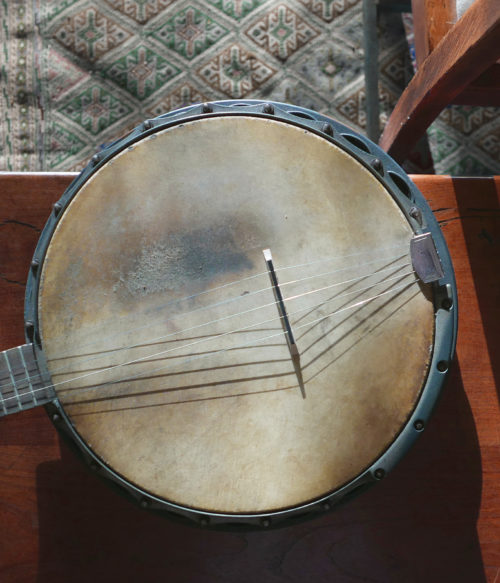 This Banjo has a unique tone, that only comes from a Gretsch Die-cast metal shell/flange construction, prewar banjo. But it’s rare to see these banjos in anything other than tenor. This one is a rare, original 5 string configuration, and has a nice “Gretsch growl” (a term that some drummers use to describe Gretsch drums). Wonderful, dark tone, with bell-like high notes. And with a bit of sustain that is reminiscent of a prewar Dobro guitar. Growl, plus sustain, and ringing highs – only from a Gretsch prewar banjo. Pearloid heastock overlay. 11 inch head. 26 inch scale length. 22-fret Brazilian rosewood fingerboard, with dot markers. Walnut neck, and resonator. Top tension head adjustment with 20 lugs. Original calf skin head. Price: $750.
This Banjo has a unique tone, that only comes from a Gretsch Die-cast metal shell/flange construction, prewar banjo. But it’s rare to see these banjos in anything other than tenor. This one is a rare, original 5 string configuration, and has a nice “Gretsch growl” (a term that some drummers use to describe Gretsch drums). Wonderful, dark tone, with bell-like high notes. And with a bit of sustain that is reminiscent of a prewar Dobro guitar. Growl, plus sustain, and ringing highs – only from a Gretsch prewar banjo. Pearloid heastock overlay. 11 inch head. 26 inch scale length. 22-fret Brazilian rosewood fingerboard, with dot markers. Walnut neck, and resonator. Top tension head adjustment with 20 lugs. Original calf skin head. Price: $750. -
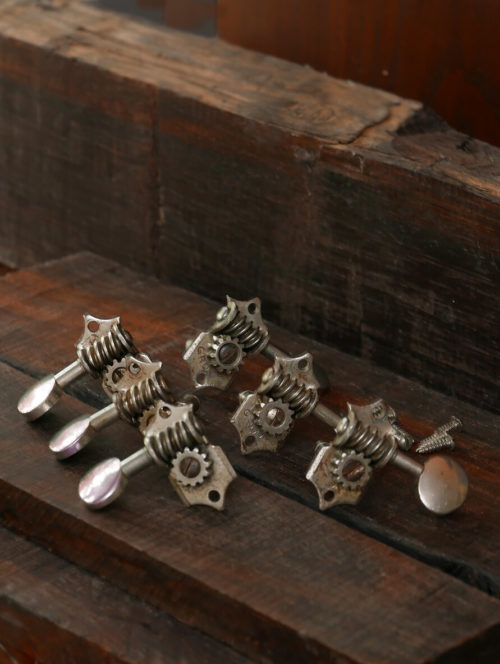 6:1 ratio pre war Grovers, mid-1930's. As used on Martin pre-war dreadoaught guitars. Oval buttons, bevelled edges on the baseplate. Just one button has some missing chrome on one side (see photos). With bushings, and mounting screws. No bent shafts. Good working condition. Price: $795.
6:1 ratio pre war Grovers, mid-1930's. As used on Martin pre-war dreadoaught guitars. Oval buttons, bevelled edges on the baseplate. Just one button has some missing chrome on one side (see photos). With bushings, and mounting screws. No bent shafts. Good working condition. Price: $795. -
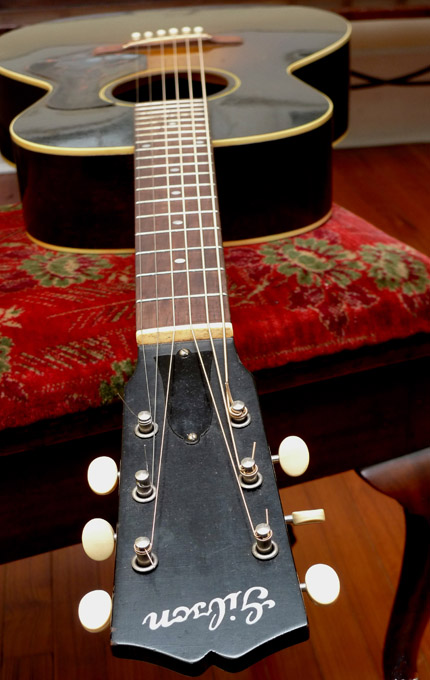 Crack-free, and 100% original, down to the bridge pins, and the original Geib case. Just getting a neck set to make it play perfectly.
Crack-free, and 100% original, down to the bridge pins, and the original Geib case. Just getting a neck set to make it play perfectly. -
 The Larson Brothers need little introduction to the world’s top players and collectors, and they are very different instruments from the Martin and Gibson instruments that dominated the 1920’s and 30’s by their shear numbers. Larson instruments are rising in value rapidly, as they never produced the kind of volume that Martin much less Gibson produced in those decades, and they are now recognized for their magnificent workmanship and tone. The now legendary Chicago-based Larson brothers, August and Carl, did not make instruments with a “Larson” label. All of their instruments were branded and marketed for Stahl, Maurer, Prairie State, Euphonon, Dyer, Bruno, and a few more. Yet every one of their instruments has their unmistakable trademarks. And their unmistakable tone. This exquisitely beautiful, 100% original Larson Mandolin was made at the very height of the Larson legacy– when they were making their finest instruments. It has all of the Larson trademarks that set apart the best Larsons, including “built under tension” design, and Larson’s classic “ebony under the binding” on the neck. Every part of this instrument is 100% original. And its crack-free– save for two tiny dryness finish cracks near center of back, of about two inches each.
The Larson Brothers need little introduction to the world’s top players and collectors, and they are very different instruments from the Martin and Gibson instruments that dominated the 1920’s and 30’s by their shear numbers. Larson instruments are rising in value rapidly, as they never produced the kind of volume that Martin much less Gibson produced in those decades, and they are now recognized for their magnificent workmanship and tone. The now legendary Chicago-based Larson brothers, August and Carl, did not make instruments with a “Larson” label. All of their instruments were branded and marketed for Stahl, Maurer, Prairie State, Euphonon, Dyer, Bruno, and a few more. Yet every one of their instruments has their unmistakable trademarks. And their unmistakable tone. This exquisitely beautiful, 100% original Larson Mandolin was made at the very height of the Larson legacy– when they were making their finest instruments. It has all of the Larson trademarks that set apart the best Larsons, including “built under tension” design, and Larson’s classic “ebony under the binding” on the neck. Every part of this instrument is 100% original. And its crack-free– save for two tiny dryness finish cracks near center of back, of about two inches each.- 100% original finish, everywhere
- Scale length: 13 inches
- Nut width: 1 1/8 inches
- Serial number: 38764
-
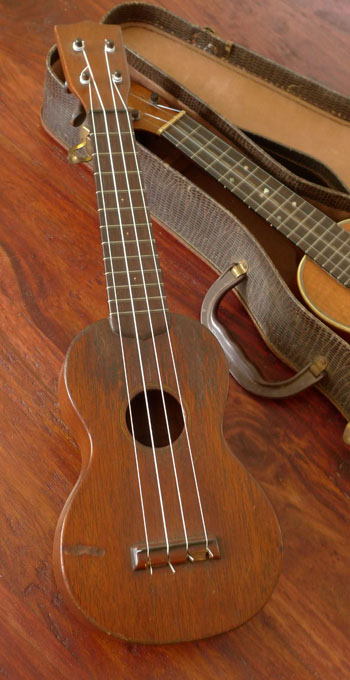 A pre-decal Uke from Martin. Style 0, with no body binding. Well worn, but 100% crack free.
A pre-decal Uke from Martin. Style 0, with no body binding. Well worn, but 100% crack free. -
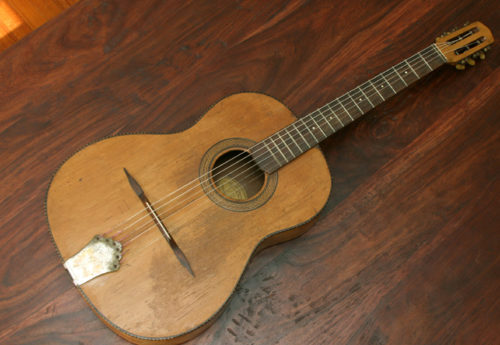 When Martin entered into its “Golden Age” for the flat top guitar, the jazz guitar was evolving on a parallel and equally important track. And in Europe, especially France, they had their own ideas about guitar making, and produced some brilliant guitars in this era–including of course the wonderful Selmer gypsy jazz guitar. The brothers Gerome were among the best luthiers in Mirecourt, France, a city famous in Europe for producing the finest gypsy and jazz guitars, in the 20s, 30s, and 40s. This all original, gypsy style guitar has maple back and sides, to give that high, twangy tone, just what you want in a django-style guitar. This one has loud piercing trebles–the treble strings are louder and more piercing than any guitar of any kind I have ever heard. Only maple produces that loud sharp treble. The volume of this instrument is striking, and there is almost a “reverb”, resonant quality to the tone. Solid spruce top. Black & white checkerboard marquetry binding on top, and rosette. It has a very thick rosewood fingerboard (over 4/10 inches/10.5mm thick!) Maple neck. Nut just shy of 1 7/8 inch. Wonderful bakelite buttons on the tuners. And it would not be a genuine gypsy jazz classic, if it did not have the hallmarks of this style: the original “floating bridge”–not an “adjustable brigde” for height, but a floating rosewood bridge that is not glued to the top, but held on by string tension (the “wings” of the bridge are glued to the top in this configuration). (You can of course change the intonation with this set-up.) The other feature that is a must, is the “zero fret”, i.e. there is a fret (the “zero” fret) right in front of the nut. 14-5/8 inch wide at lower bout. All original finish. A couple of small cracks on top. Top center seam repair. Original T-frets show wear, but still work fine. No buzzing. Action is good. Takes loop-end strings (available from many sources–Savarez Argentine strings are great on this instrument).
When Martin entered into its “Golden Age” for the flat top guitar, the jazz guitar was evolving on a parallel and equally important track. And in Europe, especially France, they had their own ideas about guitar making, and produced some brilliant guitars in this era–including of course the wonderful Selmer gypsy jazz guitar. The brothers Gerome were among the best luthiers in Mirecourt, France, a city famous in Europe for producing the finest gypsy and jazz guitars, in the 20s, 30s, and 40s. This all original, gypsy style guitar has maple back and sides, to give that high, twangy tone, just what you want in a django-style guitar. This one has loud piercing trebles–the treble strings are louder and more piercing than any guitar of any kind I have ever heard. Only maple produces that loud sharp treble. The volume of this instrument is striking, and there is almost a “reverb”, resonant quality to the tone. Solid spruce top. Black & white checkerboard marquetry binding on top, and rosette. It has a very thick rosewood fingerboard (over 4/10 inches/10.5mm thick!) Maple neck. Nut just shy of 1 7/8 inch. Wonderful bakelite buttons on the tuners. And it would not be a genuine gypsy jazz classic, if it did not have the hallmarks of this style: the original “floating bridge”–not an “adjustable brigde” for height, but a floating rosewood bridge that is not glued to the top, but held on by string tension (the “wings” of the bridge are glued to the top in this configuration). (You can of course change the intonation with this set-up.) The other feature that is a must, is the “zero fret”, i.e. there is a fret (the “zero” fret) right in front of the nut. 14-5/8 inch wide at lower bout. All original finish. A couple of small cracks on top. Top center seam repair. Original T-frets show wear, but still work fine. No buzzing. Action is good. Takes loop-end strings (available from many sources–Savarez Argentine strings are great on this instrument). -
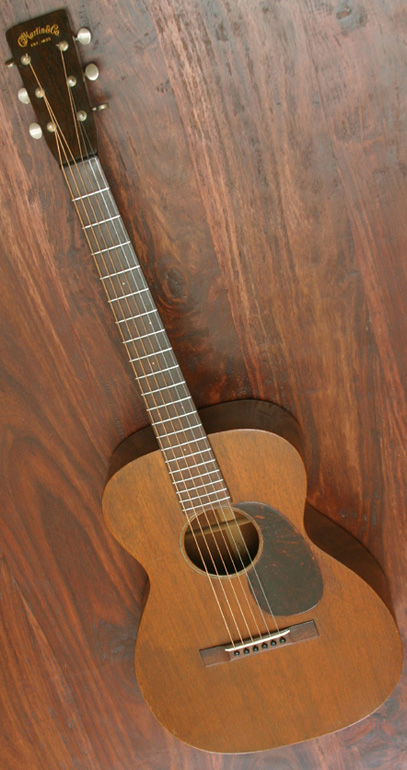 It’s rare to find a Golden Era Martin in this condition. This wonderful, completely crack-free 14-fret guitar from the 30’s is a gem. It’s one of the very first Martins of any style to have all three: 14 frets clear of body+Martin decal on the front of the peghead+Martin stamp the back of the peghead. Mahogany top, back and sides, of course, and it has the great, resonant feel and tone of a very lightly built 12-fret, but with more volume, in a 14-fret package. Strong bass response. 1 3/4 inch nut. Original finish, everywhere; no cracks anywhere. Original tuners. Original full-height bridge and maple bridge plate. Original bridge pins, and nut. The neck was recently set, so there is a new bone saddle, and the action is nice and low. Original bar frets. Some slight wear below the pick guard (not a hint of a crack or even any shrinking of the edges of the pick guard), and a variety of minor dings– but this completely crack-free guitar from the Martin Golden era is a gem.
It’s rare to find a Golden Era Martin in this condition. This wonderful, completely crack-free 14-fret guitar from the 30’s is a gem. It’s one of the very first Martins of any style to have all three: 14 frets clear of body+Martin decal on the front of the peghead+Martin stamp the back of the peghead. Mahogany top, back and sides, of course, and it has the great, resonant feel and tone of a very lightly built 12-fret, but with more volume, in a 14-fret package. Strong bass response. 1 3/4 inch nut. Original finish, everywhere; no cracks anywhere. Original tuners. Original full-height bridge and maple bridge plate. Original bridge pins, and nut. The neck was recently set, so there is a new bone saddle, and the action is nice and low. Original bar frets. Some slight wear below the pick guard (not a hint of a crack or even any shrinking of the edges of the pick guard), and a variety of minor dings– but this completely crack-free guitar from the Martin Golden era is a gem. -
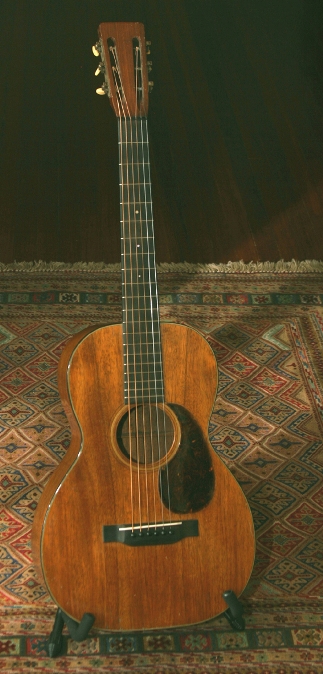 We converted this Golden Era 12-fret Koa Martin from the original Hawaiian setup ourselves, so it's perfect. The instrument does not have a crack anywhere. All original finish. Original Ebony bridge, converted from the tall Hawaiian set-up to a normal 30's set-up. Same with the ebony nut. All new, period-perfect Bar Frets. We radiused the ebony fretboard to 30's Martin specs. Neck was set and action is perfect. 1-7/8 inch nut width. Original tuners. Original bridge plate. Minor nicks and dings on top and back, but with the all original finish and crack-free, it's a rare specimen. Nothing compares in tone to an all-Koa Golden Age Martin. Koa blends the midrange of mahogany with the top end of maple-or, in the case of a fine 30's Koa Martin- hints of Brazilian rosewood. This fine 0-18K has all you would want from a Koa Martin, with the clearest, bell-like treble string tone imaginable.
We converted this Golden Era 12-fret Koa Martin from the original Hawaiian setup ourselves, so it's perfect. The instrument does not have a crack anywhere. All original finish. Original Ebony bridge, converted from the tall Hawaiian set-up to a normal 30's set-up. Same with the ebony nut. All new, period-perfect Bar Frets. We radiused the ebony fretboard to 30's Martin specs. Neck was set and action is perfect. 1-7/8 inch nut width. Original tuners. Original bridge plate. Minor nicks and dings on top and back, but with the all original finish and crack-free, it's a rare specimen. Nothing compares in tone to an all-Koa Golden Age Martin. Koa blends the midrange of mahogany with the top end of maple-or, in the case of a fine 30's Koa Martin- hints of Brazilian rosewood. This fine 0-18K has all you would want from a Koa Martin, with the clearest, bell-like treble string tone imaginable. -
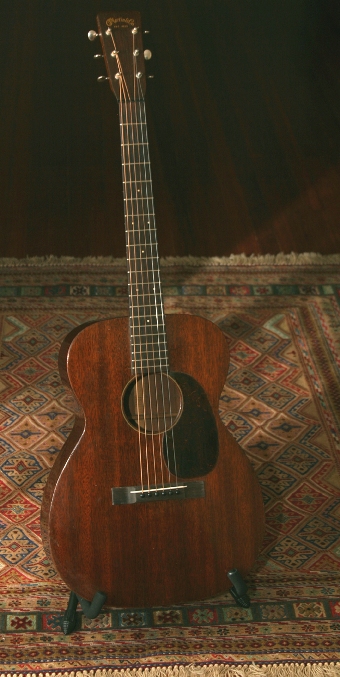 This model is something of a sleeper on the Golden Era Martin guitar market, because there are just not that many pre-1939 00-17s available. There are quite a few war-time and post-war 00-17s, but a 00-17 with full pre-war specs, forward shifted X-bracing, and 1 3/4 inch nut, is hard to come by–and they have all the great qualities of 00-sized Golden Era Martins that cost twice or three times the price on the vintage market–for now, as these great pre-war 00-17s will catch up quickly. The tone and volume of this 00-17 is astounding: full, amazingly bright, and with impressive volume. 1-3/4 inch nut width. Crack-free except for a well-repaired crack on bass side, about 2 inches long, that's difficult to see even up close. No cracks at all on top, or back. All original finish. Original bridge plate. This model has of course a mahogany top as well as mahogany back and sides. And with that dark look and original gloss finish that really sets this Golden Age Martin apart in its own class. Neck has the typically slightly beefier profile that's the hallmark of the best 30's 14-fret Martins. Neck was set by us. Replaced, period-correct Brazilian rosewood bridge. Original ebony nut. All new T-frets installed by us. Original tuners.
This model is something of a sleeper on the Golden Era Martin guitar market, because there are just not that many pre-1939 00-17s available. There are quite a few war-time and post-war 00-17s, but a 00-17 with full pre-war specs, forward shifted X-bracing, and 1 3/4 inch nut, is hard to come by–and they have all the great qualities of 00-sized Golden Era Martins that cost twice or three times the price on the vintage market–for now, as these great pre-war 00-17s will catch up quickly. The tone and volume of this 00-17 is astounding: full, amazingly bright, and with impressive volume. 1-3/4 inch nut width. Crack-free except for a well-repaired crack on bass side, about 2 inches long, that's difficult to see even up close. No cracks at all on top, or back. All original finish. Original bridge plate. This model has of course a mahogany top as well as mahogany back and sides. And with that dark look and original gloss finish that really sets this Golden Age Martin apart in its own class. Neck has the typically slightly beefier profile that's the hallmark of the best 30's 14-fret Martins. Neck was set by us. Replaced, period-correct Brazilian rosewood bridge. Original ebony nut. All new T-frets installed by us. Original tuners. -
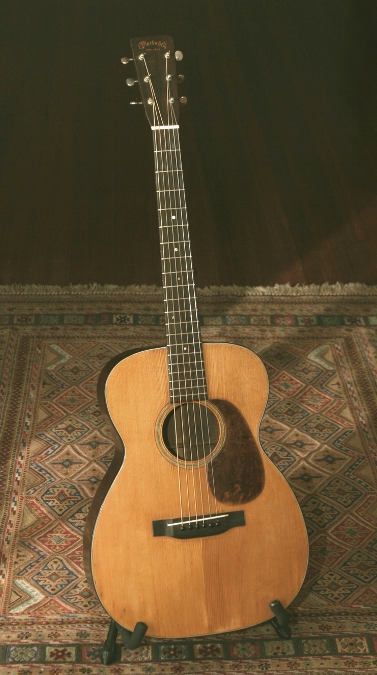 Probably the best year ever for 14-fret 00-18s. In the Golden Age of 14-fret Martins from the early 30's until the late 30's, only in 1936 did Martin use Brazilian rosewood (as opposed to ebony) for the fretboard and bridges of 18's, so its tone is considered by many to be the best in the 14 fret, 1-3/4 inch nut era. The guitar is crack-free on the top and back. Just one repaired crack on the treble side.The repair is well done and almost impossible to see from the outside (older repair has muslin cloth on inside-luthiers agree that these older cloth patches inside a vintage Martin should be left in place). Original tuners. Original bridge plate. Original nut. Replaced T-frets by us. Replacement bridge-very dark Brazilian rosewood bridge made to original specs in our shop, and ivory saddle. The neck has that wonderful mid-thirties slightly fatter profile. Neck set by us. And the tone is the best example of a Golden Era 00-18 you'll find anywhere. Light overspray (no refinishing) on back and sides (not top, neck or head).
Probably the best year ever for 14-fret 00-18s. In the Golden Age of 14-fret Martins from the early 30's until the late 30's, only in 1936 did Martin use Brazilian rosewood (as opposed to ebony) for the fretboard and bridges of 18's, so its tone is considered by many to be the best in the 14 fret, 1-3/4 inch nut era. The guitar is crack-free on the top and back. Just one repaired crack on the treble side.The repair is well done and almost impossible to see from the outside (older repair has muslin cloth on inside-luthiers agree that these older cloth patches inside a vintage Martin should be left in place). Original tuners. Original bridge plate. Original nut. Replaced T-frets by us. Replacement bridge-very dark Brazilian rosewood bridge made to original specs in our shop, and ivory saddle. The neck has that wonderful mid-thirties slightly fatter profile. Neck set by us. And the tone is the best example of a Golden Era 00-18 you'll find anywhere. Light overspray (no refinishing) on back and sides (not top, neck or head). -
 Another Gibson L-00, with great tone and volume, and all original finish. The top and sides are completely crack-free, and there are several small dryness cracks on the back. The bridge is original, and has never been off the guitar. We just set the neck, and installed a new bone saddle. The bridge plate is original and in perfect condition. Original firestripe pickguard. Original nut. Original frets.
Another Gibson L-00, with great tone and volume, and all original finish. The top and sides are completely crack-free, and there are several small dryness cracks on the back. The bridge is original, and has never been off the guitar. We just set the neck, and installed a new bone saddle. The bridge plate is original and in perfect condition. Original firestripe pickguard. Original nut. Original frets. -
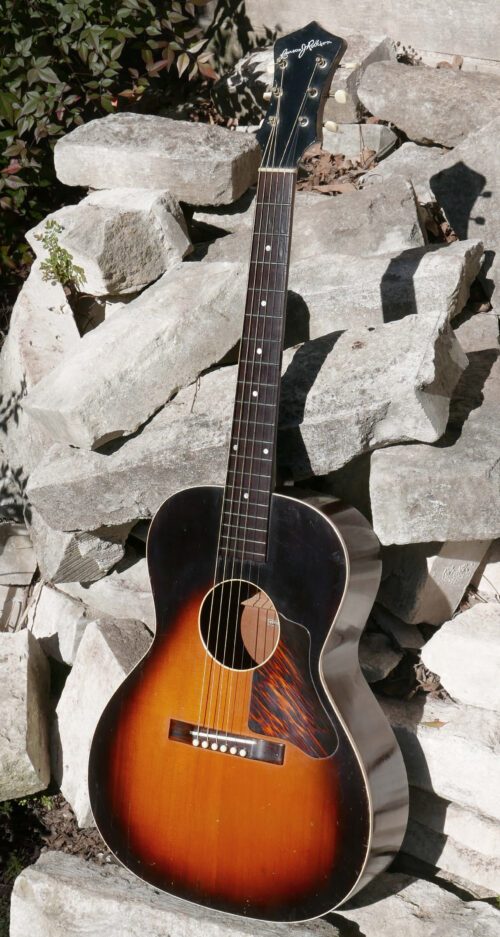 Made in 1937 – it is stamped inside from the Gibson/Kalamazoo factory: “September 1937” • Gibson L-00 (and same as Kalamazoo) body shape with ladder-bracing... all were made in the same Gibson factory. • 24 3/4" Gibson scale length • 1 3/4" nut width • Classic V-shape neck profile, typical of the golden age Gibsons of the mid-1930’s • Adirondack spruce top • Mahogany back and sides • 100% original finish, everywhere • Three hairline cracks on top that are hard to see. (upper bout; bass side near fretboard extension; and below bridge.) They’ve been glued inside. Couple of cracks on back, also have been addressed. Sides are crack-free. • Original Gibson firestripe pick guard • Original tuners (the G string tuner is bent a bit – we prefer to leave it like it is, it works fine, rather than bend it back) • Original Brazilian rosewood bridge, has never been off the guitar. • Brazilian rosewood fingerboard, shows a bit of wear • Original frets, in good condition • Original nut • Original small Maple bridge plate; and all braces inside are original and in great condition. • In a modern hard shell case Price: $3950.
Made in 1937 – it is stamped inside from the Gibson/Kalamazoo factory: “September 1937” • Gibson L-00 (and same as Kalamazoo) body shape with ladder-bracing... all were made in the same Gibson factory. • 24 3/4" Gibson scale length • 1 3/4" nut width • Classic V-shape neck profile, typical of the golden age Gibsons of the mid-1930’s • Adirondack spruce top • Mahogany back and sides • 100% original finish, everywhere • Three hairline cracks on top that are hard to see. (upper bout; bass side near fretboard extension; and below bridge.) They’ve been glued inside. Couple of cracks on back, also have been addressed. Sides are crack-free. • Original Gibson firestripe pick guard • Original tuners (the G string tuner is bent a bit – we prefer to leave it like it is, it works fine, rather than bend it back) • Original Brazilian rosewood bridge, has never been off the guitar. • Brazilian rosewood fingerboard, shows a bit of wear • Original frets, in good condition • Original nut • Original small Maple bridge plate; and all braces inside are original and in great condition. • In a modern hard shell case Price: $3950.